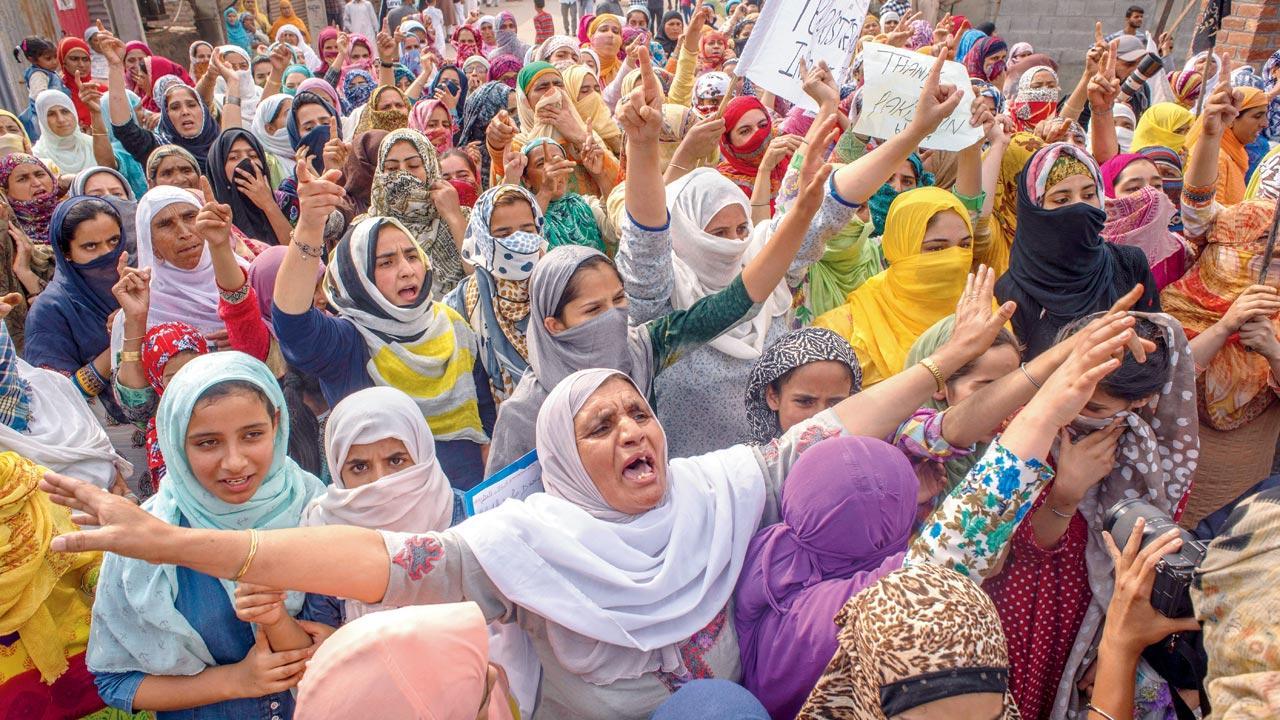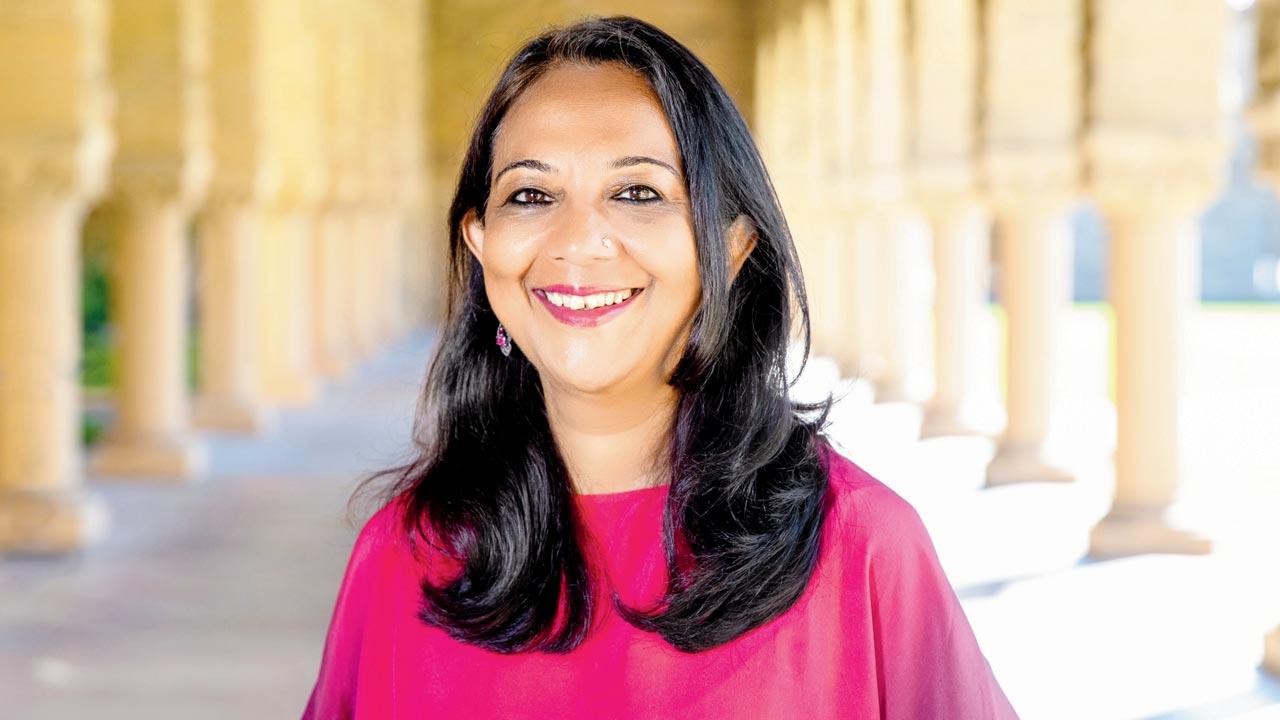The rift is larger between Delhi and Kashmir, says Jammu-based journalist Anuradha Bhasin who has just released a book documenting the abrogation of Article 370

Kashmiri women protesting the abrogation of Article 370 after Friday prayers in September 2019. Pic Courtesy/Getty Images
I still haven’t figured out where I fit in,” says Jammu-based journalist Anuradha Bhasin, as she sits down with us for a video interview from across the Atlantic ocean. “All my life, I have shuttled between Jammu and Srinagar so both places were mine. But with the abrogation of Article 370, I belong nowhere, neither to Jammu where majority of the voices were that of celebration because of the recent Right-wing influence, nor in Kashmir, where I am an outsider too,” she laments.
ADVERTISEMENT
A journalist for over three decades and the executive editor of Kashmir Times, Jammu and Kashmir’s oldest English daily, Bhasin has just released a book, A Dismantled State: The Untold Story of Kashmir After Article 370 (HarperCollins) and is currently a John S Knight Fellow (2022-2023) at Stanford University, California.
 Anuradha Bhasin. Pic Courtesy/Douglas Zimmerman
Anuradha Bhasin. Pic Courtesy/Douglas Zimmerman
On August 5, 2019, the BJP-led central government revoked Article 370 which was part of its election manifesto. It also divided the state into two Union Territories—one of J&K (combining both Muslim majority Kashmir and Hindu majority Jammu) and the other of Ladakh (with Buddhish majority). When in place, Article 370 allowed J&K the power to make its own rules pertaining to permanent residency, ownership and buying of land. It also disallowed people from other states from purchasing property in the state. “Jammu and Kashmir is not a homogeneous region which might appear so from its abbreviation. Kashmir Valley has a predominantly Muslim population with a distinct Kashmiri identity—linguistic, ethnic, and political, that they attach to. Even within Jammu there are different regions. But J&K was important for me. Throughout my journalism career and even as an activist, I acted as a bridge for dialogue between different communities. With Article 370 revoked, suddenly everything started drifting further apart,” Bhasin tells us.
The distinct identity that the state enjoyed, she says, was a binding factor bringing people together and closer to the Indian mainland. The snatching away of it, however, according to Bhasin, made the distance even more unbridgeable.
Sharing the feeling that loomed back in 2019, Bhasin recalls, “Days before the abrogation, there were different kinds of rumours floating around. The Amarnath Yatra had been halted, which was unprecedented. Tourists were being picked up and shifted out of the state. There was utter chaos, fear and panic mostly in Kashmir. Everyone felt some kind of military action was inevitable as a large number of troops were being deployed all around. Activists, journalists, and politicians including three former chief ministers of Kashmir, were put behind bars in the days preceding the announcement.”
“Even at night,” Bhasin continues, “there were sorties of flights. I stay close to the Jammu airport which also has the defence airport. It was unsettling.” The first warning sign Bhasin got about events extending outside of Kashmir valley, was when her driver came in at 7 am with news of the imposition of Section 144 of the CrPC in the state. This gave the power to issue order in urgent cases of nuisance of apprehended danger. It also restricts public gathering of four and more people. The Parliament was also meeting, which cemented a lot of apprehensions around, she says. “We were in complete shock,” she states. While the BJP had been talking about revoking Article 370, Bhasin says, people did not believe it was constitutionally possible. “After a week of celebrations, majorly in Jammu, when the dust settled, people [including the minority Hindus] realised that they had been demoted to a UT from a state, had lost special status which also meant losing territory and were unsure if the government would protect their land rights or not.”
She adds, “Because there is always this distinction between people of Kashmir valley and that of Jammu, so if anything bad happens to Kashmir valley, people in Jammu just assume it is good for them and that was the initial sentiment with revocation of Article 370 too. Later, the anxieties around outsiders coming to J&K to buy property, will there be protection of land rights like in Himachal Pradesh and other concerns started to sink in.”
Bhasin also clarified that it was a mere myth propagated that women will be able to retain land purchase rights in J&K, even after marrying outside. “Women already had that right through a court order in 2005.” She started writing the book as an experimental documentation of Kashmiri voices, of concerns and facts around Article 370.
Life, Bhasin says, continues to be impacted because of the step. “Article 370 was a hollow shell. The only protection people had was related to land, jobs and business, which today, is taken away. You cannot wish to Indianise them by pushing them further away and increasing the distance between New Delhi and Kashmir,” she explains.
 Subscribe today by clicking the link and stay updated with the latest news!" Click here!
Subscribe today by clicking the link and stay updated with the latest news!" Click here!







